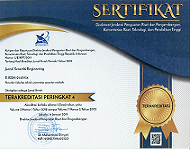Potensi Limbah Media Tanam Jamur Tiram dan Jamur Merang sebagai Bahan Baku Pembuatan Kompos Organik
Keywords:
Kompos, Limbah Jamur, Baglog, Rasio C/N, Unsur Hara, KompostingAbstract
The cultivation of oyster mushrooms (Pleurotus ostreatus) and straw mushrooms (Volvariella volvacea) generates large amounts of organic waste, particularly spent growing media such as baglogs and fermented straw. This study aims to evaluate the effectiveness of combining oyster mushroom baglog waste with straw mushroom cultivation residue in producing high-quality compost. he method used was aerobic composting with seven variations of mixing ratios, supplemented with goat manure and biological activators (M-21 and molasses). The observed parameters included temperature, pH, moisture content, organic carbon content, carbon-to-nitrogen ratio (C/N), and macronutrient content (N + P₂O₅ + K₂O). The results showed that the combination of oyster mushroom waste and straw mushroom waste at a 2:3 ratio produced optimal decomposition conditions, yielding the highest compost quality in accordance with the Indonesian National Standard (SNI). The resulting compost met the quality standards based on SNI 7763:2024, particularly with respect to a maximum C/N ratio of 25, a minimum organic carbon content of 15%, a minimum macronutrient content (N + P₂O₅ + K₂O) of 2%, and a stable, near-neutral pH. These findings suggest that a proportional combination of both types of mushroom waste can serve as an effective and sustainable solution for organic waste management in support of environmentally friendly agriculture.
References
[1] Fauziyah, L., Suharto, I., & Azizah, R. Studi penggunaan kompos limbah baglog jamur tiram pada pertumbuhan tanaman sawi. Jurnal Agroteknologi, 14(1), 20–27, 2020.
[2] Sulaiman, A. Pemanfaatan limbah media jamur sebagai kompos untuk memperbaiki kualitas tanah. Jurnal Biologi Tropis, 11(1), 41–47, 2011.
[3] Pratomo, H., & Prasetyo, B. Pembuatan Pupuk Kompos Berbahan Feses Kambing menggunakan Bantuan Effective Microorganism (EM4), Kegiatan Abdimas di Desa Tegal. Prosiding Konferensi Nasional Pengabdian Kepada Masyarakat dan Corporate Social Responsibility (PKM-CSR), 1, 403-412, 2018.
[4] Hunaepi, H., Muliana, U., & Mulyadi, Y. Pembuatan kompos dari limbah media tanam jamur tiram menggunakan EM4. Jurnal Sains dan Teknologi Lingkungan, 6(2), 135–141, 2014.
[5] Bernal, M. P., Alburquerque, J. A., & Moral, R. Composting of animal manures and chemical criteria for compost maturity assessment: A review. Bioresource Technology, 100(22), 5444–5453, 2009. https://doi.org/10.1016/j.biortech.2008.11.027
[6] Sari, A. P., Dewi, R. K., & Setiawan, R. Karakteristik limbah baglog jamur tiram dan potensi pemanfaatannya sebagai kompos. Jurnal Rekayasa Lingkungan, 16(2), 85–92, 2020.
[7] Prasetya, R. T., & Widyaningrum, P. Pemanfaatan limbah media tanam jamur merang sebagai bahan baku kompos. Jurnal Agroindustri, 7(2), 100–106, 2018
[8] N. K. R. Wulandari, I. G. B. Madrini, and I. M. A. S. Wijaya, "Efek Penambahan Limbah Makanan terhadap C/N Ratio pada Pengomposan Limbah Kertas," METODE, vol. 19, pp. 7030–2004, 2020.
[9] B. Madrini, S. Shibusawa, Y. Kojima, and S. Hosaka, "Effect of natural zeolite (clinoptilolite) on ammonia emission of leftover food-rice hulls composting at the initial stage of the thermophilic process," Journal of Agricultural Machinery, vol. 70, no. 2, pp. 12–19, 2016.
[10] Y. H. Indriani, Membuat Kompos Secara Kilat. Jakarta: Penebar Swadaya, 2002.
[11] Y. S. Dewi and Treesnowati, Pengolahan Sampah Skala Rumah Tangga Menggunakan Metode Komposting. Jakarta: Teknik Lingkungan Universitas Satya Negara Indonesia, 2012.
[12] R. T. Harahap, T. Sabrina, and P. Marbun, "Penggunaan Beberapa Sumber dan Dosis Aktivator Organik Untuk Meningkatkan Laju Dekomposisi Kompos Tandan Kosong Kelapa Sawit," Jurnal Online Agroekoteknologi, vol. 3, no. 2, pp. 581–589, Mar. 2015.
[13] E. S. Pandebesie and D. Rayuanti, "Pengaruh penambahan sekam pada proses pengomposan sampah domestik," Jurnal Lingkungan Tropis, vol. 6, no. 1, pp. 31–40, 2013.
[14] N. Ekawandani and A. A. Kusuma, "Pengomposan Sampah Organik (Kubis dan Kulit Pisang) dengan Menggunakan EM4," TEDC, vol. 12, no. 1, pp. 38–43, Jan. 2018.
[15] B. N. Widarti, W. K. Wardhini, and E. Sarwono, "Pengaruh rasio C/N bahan baku pada pembuatan kompos dari kubis dan kulit pisang," Jurnal Integrasi Proses, vol. 5, no. 2, pp. 75–80, 2015.
[16] Hajama, "Studi Pemanfaatan Eceng Gondok sebagai Bahan Pembuatan Pupuk Kompos dengan Menggunakan Aktivator EM4 dan MOL serta Prospek Pengembangannya," Sarjana thesis, Teknik Lingkungan, Universitas Hasanuddin, Makassar, 2014.
[17] Sriharti and T. Salim, "Pemanfaatan sampah taman (rumput-rumput) untuk pembuatan kompos," in Prosiding Seminar Nasional Teknik Kimia “Kejuangan”, Yogyakarta, Jan. 26, 2010, pp. 1–8.
[18] B. Bachtiar and A. H. Ahmad, "Analisis kandungan hara kompos johar Cassia siamea dengan penambahan aktivator promi," Bioma: Jurnal Biologi Makassar, vol. 4, no. 1, pp. 68–76,2019.
Downloads
Published
Issue
Section
License
Copyright (c) 2025 Angge Dhevi Warisaura, Mukasi Wahyu Kurniawati, Venditias Yudha (Author)

This work is licensed under a Creative Commons Attribution 4.0 International License.












